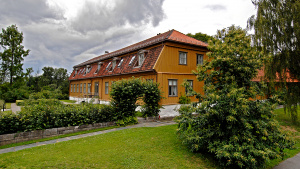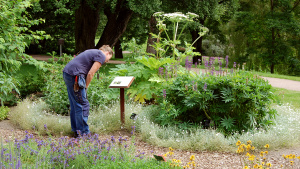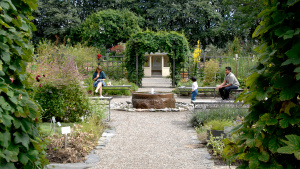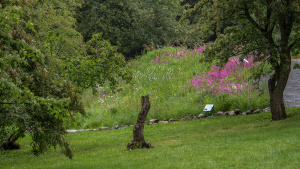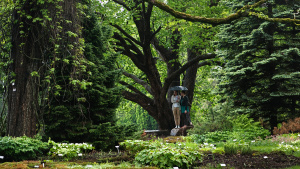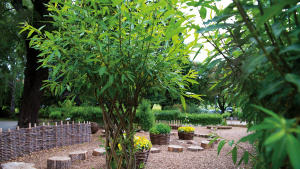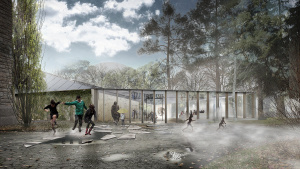Forskjell mellom versjoner av «Walks+Talks: Botanical Garden»
| (5 mellomliggende revisjoner av samme bruker vises ikke) | |||
| Linje 1: | Linje 1: | ||
| − | + | ||
| − | [[Fil:Map Botanisk hage IFLA WORLD KONGRESS 2019.jpg|miniatyr|600x600pk]] | + | [[Fil:Map Botanisk hage IFLA WORLD KONGRESS 2019.jpg|miniatyr|600x600pk]] |
| − | |||
| − | |||
| − | |||
| − | |||
| − | |||
| − | |||
= '''Botanical Garden''' = | = '''Botanical Garden''' = | ||
| Linje 25: | Linje 19: | ||
[[Fil:Rød Svartlistebed.jpg|miniatyr|Foto: Kristina Bjureke / IFLA 2019]] | [[Fil:Rød Svartlistebed.jpg|miniatyr|Foto: Kristina Bjureke / IFLA 2019]] | ||
| − | = Red- and | + | = Red- and blacklisted plants = |
{{#coordinates:59.917314|10.770281|name=Red- and black-listed plants}} | {{#coordinates:59.917314|10.770281|name=Red- and black-listed plants}} | ||
Demonstration facility for communication on threatened Norwegian plants, parallel with invasive foreign species. This small facility is much used in the teaching of biological diversity and protection ideology. | Demonstration facility for communication on threatened Norwegian plants, parallel with invasive foreign species. This small facility is much used in the teaching of biological diversity and protection ideology. | ||
| Linje 35: | Linje 29: | ||
The herb garden has plants which have been in use, or are still being used, as cultivated crops. In different areas we show plants that can be used to colour wool, to produce fibres and thread, for medicine, spices and food. The area has been harmoniously laid out and has a comfortable seating area in the centre of the garden. | The herb garden has plants which have been in use, or are still being used, as cultivated crops. In different areas we show plants that can be used to colour wool, to produce fibres and thread, for medicine, spices and food. The area has been harmoniously laid out and has a comfortable seating area in the centre of the garden. | ||
---- | ---- | ||
| + | [[Fil:Slåttemark.jpg|miniatyr|Foto: IFLA 2019]] | ||
| + | |||
= Oslo ridge = | = Oslo ridge = | ||
{{#coordinates:59.916815|10.768548|name=Oslo ridge}} | {{#coordinates:59.916815|10.768548|name=Oslo ridge}} | ||
| Linje 40: | Linje 36: | ||
geology from the cambrosilurian period that contributes to a unique plant life. The limestone is from the area of the former airport at Fornebu. We also have a protective bed for highly threatened Norwegian species, both for living protection and seeds protected in our national seed bank. Several nature types in Norway are now threatened, and there is a ‘red list’ for them, in addition to the list of single species. | geology from the cambrosilurian period that contributes to a unique plant life. The limestone is from the area of the former airport at Fornebu. We also have a protective bed for highly threatened Norwegian species, both for living protection and seeds protected in our national seed bank. Several nature types in Norway are now threatened, and there is a ‘red list’ for them, in addition to the list of single species. | ||
---- | ---- | ||
| + | [[Fil:Skandinavisk rygg.jpg|miniatyr|Foto: Guri Dahl / IFLA 2019]] | ||
| + | |||
= Scandinavian ridge = | = Scandinavian ridge = | ||
{{#coordinates:59.917615|10.768859|name=Scandinavian ridge}} | {{#coordinates:59.917615|10.768859|name=Scandinavian ridge}} | ||
At the top of The Mountain Garden we find the ‘Scandinavian ridge’, where we cultivate small areas of Norwegian mountain plants. At the ‘Scandinavian ridge’, we show how different geologies create varied soil conditions, whereby vegetation also will vary. Stones in this area have been collected from many places in the country. Here you may also find rest on one of our finest benches made by shale in a circle around what is perhaps our oldest tree, a Turkish hazel. | At the top of The Mountain Garden we find the ‘Scandinavian ridge’, where we cultivate small areas of Norwegian mountain plants. At the ‘Scandinavian ridge’, we show how different geologies create varied soil conditions, whereby vegetation also will vary. Stones in this area have been collected from many places in the country. Here you may also find rest on one of our finest benches made by shale in a circle around what is perhaps our oldest tree, a Turkish hazel. | ||
---- | ---- | ||
| + | [[Fil:Pilehagen.jpg|miniatyr|Foto: Ingunn Cecilie Jensen]] | ||
| + | |||
= Great-grandmothers garden = | = Great-grandmothers garden = | ||
{{#coordinates:59.919081|10.771233|name=Great-grandmothers garden}} | {{#coordinates:59.919081|10.771233|name=Great-grandmothers garden}} | ||
Then we arrive at a completely different area. A botanical garden is like many rooms in the room. ‘Great-grandmothers garden’ is a sense-garden and a living gene bank. Here we maintain old garden plants from different areas in the eastern parts of the country, several that are now seldom found in trade. This garden is formed and prepared for wheel chairs and persons with dementia, and we hold guided tours adapted to groups from nursing homes. | Then we arrive at a completely different area. A botanical garden is like many rooms in the room. ‘Great-grandmothers garden’ is a sense-garden and a living gene bank. Here we maintain old garden plants from different areas in the eastern parts of the country, several that are now seldom found in trade. This garden is formed and prepared for wheel chairs and persons with dementia, and we hold guided tours adapted to groups from nursing homes. | ||
---- | ---- | ||
| + | [[Fil:Klimahuset.jpg|miniatyr|Foto: Lund Hagem Atlier Oslo / IFLA 2019]] | ||
| + | |||
= The Willow Garden and the new Climate House = | = The Willow Garden and the new Climate House = | ||
{{#coordinates:59.918626|10.772481|name=The Willow Garden and the new Climate House}} | {{#coordinates:59.918626|10.772481|name=The Willow Garden and the new Climate House}} | ||
Nåværende revisjon fra 17. sep. 2019 kl. 11:23
Botanical Garden
The Botanical Garden was established at Tøyen in 1814. It is part of The Museum of Natural History, Oslo University.
The development of a botanical garden was part of a nation-building process in the first part of the 1800’s. The natural sciences held a strong position, botany was seen as important in the improvement of agriculture and gardening. Important objectives for The Botanical Garden have always been the use and promotion of research and education at the university. At the same time, through all its years, the garden has been a valuable green oasis for people in the city, a place to enjoy beauty and quiet and a place to learn about plant life, in Norway and in the world. The garden is a living museum and an important part of our cultural history.
Saving biodiversity – both threatened plants in the Norwegian nature and old garden plants – is an important task. The garden has 800.000 visitors a year, and as such is an important place for valuable experiences in Oslo.
Inside the garden, there are several large museum buildings for The Museum of Natural History, covering the fields of geology, zoology, botany and mycology. In addition, we are building a new Climate House, a place for research-based exhibitions and for meetings and debates. Here, we will inspire curiosity, impart knowledge and give a foundation for action and change concerning the gravest challenges of our time – climate change.
Tøyen Manor
Tøyen Manor, one of the oldest wooden buldings in the city that is still in use. This is the only building from the time prior to the establishment of The Botanical Garden. The garden administration is located here, in addition to two exhibition rooms and a café where we will have our lunch.
Red- and blacklisted plants
Demonstration facility for communication on threatened Norwegian plants, parallel with invasive foreign species. This small facility is much used in the teaching of biological diversity and protection ideology.
The herb garden
The herb garden has plants which have been in use, or are still being used, as cultivated crops. In different areas we show plants that can be used to colour wool, to produce fibres and thread, for medicine, spices and food. The area has been harmoniously laid out and has a comfortable seating area in the centre of the garden.
Oslo ridge
Down in The Mountain Garden we find the ‘Oslo ridge’, where we show both ordinary and rare species growing on the islands and around the inner Oslo Fjord. We visualize the special geology from the cambrosilurian period that contributes to a unique plant life. The limestone is from the area of the former airport at Fornebu. We also have a protective bed for highly threatened Norwegian species, both for living protection and seeds protected in our national seed bank. Several nature types in Norway are now threatened, and there is a ‘red list’ for them, in addition to the list of single species.
At the top of The Mountain Garden we find the ‘Scandinavian ridge’, where we cultivate small areas of Norwegian mountain plants. At the ‘Scandinavian ridge’, we show how different geologies create varied soil conditions, whereby vegetation also will vary. Stones in this area have been collected from many places in the country. Here you may also find rest on one of our finest benches made by shale in a circle around what is perhaps our oldest tree, a Turkish hazel.
Great-grandmothers garden
Then we arrive at a completely different area. A botanical garden is like many rooms in the room. ‘Great-grandmothers garden’ is a sense-garden and a living gene bank. Here we maintain old garden plants from different areas in the eastern parts of the country, several that are now seldom found in trade. This garden is formed and prepared for wheel chairs and persons with dementia, and we hold guided tours adapted to groups from nursing homes.
The Willow Garden and the new Climate House
The Willow Garden is suitable for children playing. Fences, tunnels and sculptures have been made from many types of willow. The new Climate House is being built just behind, due to open in a few months.
IFLA World Congress 2019 will take a closer look at urban transformation, green mobility, healthy and beautiful landscapes and community participation. During three days in Oslo, we aim to inspire, challenge and intrigue you. We want you to share and reflect on the knowledge that is developed, presented and discussed.
Join us in moving one step further to understand and protect our COMMON GROUND.
This article is part of IFLA Common Grounds: Walk+Talk.
You can view all Walks+Talks tours here


